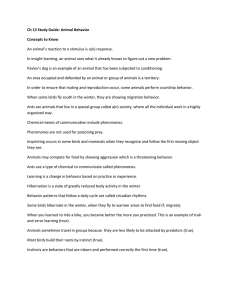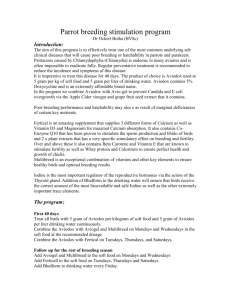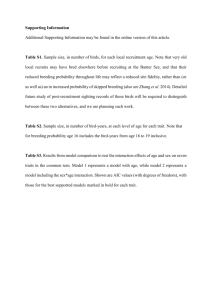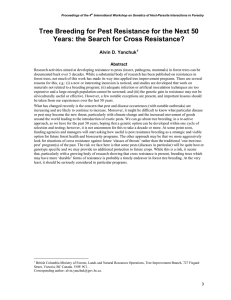The Significance of Mating System and Nonbreeding Behavior to
advertisement
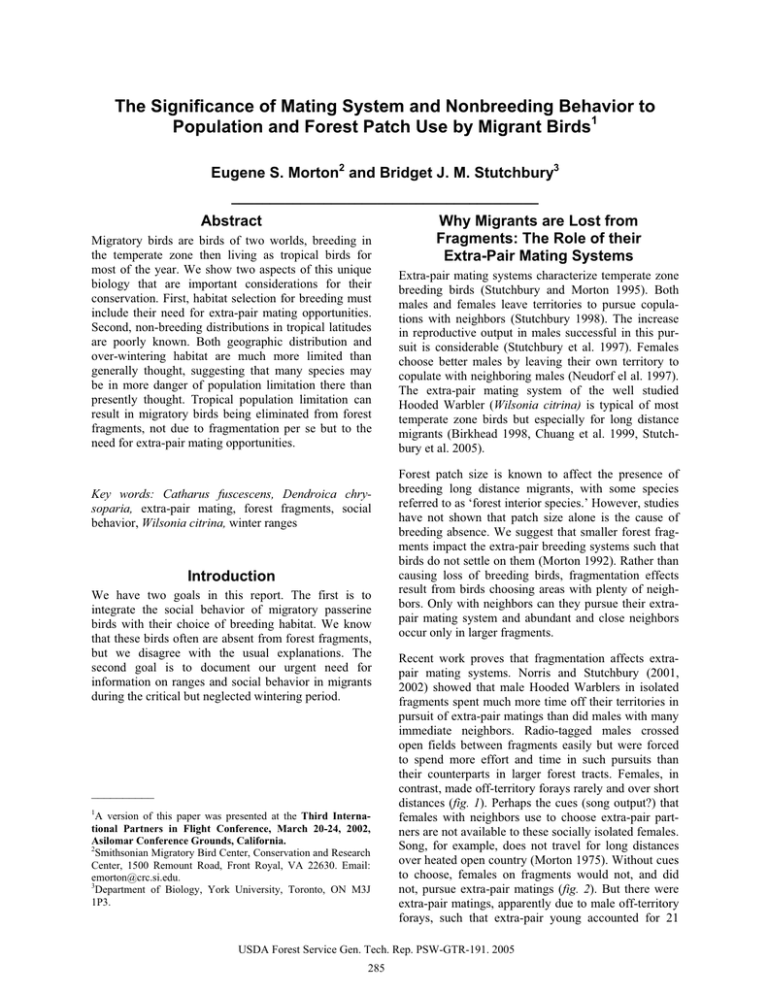
The Significance of Mating System and Nonbreeding Behavior to Population and Forest Patch Use by Migrant Birds1 Eugene S. Morton2 and Bridget J. M. Stutchbury3 ________________________________________ Abstract Migratory birds are birds of two worlds, breeding in the temperate zone then living as tropical birds for most of the year. We show two aspects of this unique biology that are important considerations for their conservation. First, habitat selection for breeding must include their need for extra-pair mating opportunities. Second, non-breeding distributions in tropical latitudes are poorly known. Both geographic distribution and over-wintering habitat are much more limited than generally thought, suggesting that many species may be in more danger of population limitation there than presently thought. Tropical population limitation can result in migratory birds being eliminated from forest fragments, not due to fragmentation per se but to the need for extra-pair mating opportunities. Key words: Catharus fuscescens, Dendroica chrysoparia, extra-pair mating, forest fragments, social behavior, Wilsonia citrina, winter ranges Introduction We have two goals in this report. The first is to integrate the social behavior of migratory passerine birds with their choice of breeding habitat. We know that these birds often are absent from forest fragments, but we disagree with the usual explanations. The second goal is to document our urgent need for information on ranges and social behavior in migrants during the critical but neglected wintering period. __________ 1 A version of this paper was presented at the Third International Partners in Flight Conference, March 20-24, 2002, Asilomar Conference Grounds, California. 2 Smithsonian Migratory Bird Center, Conservation and Research Center, 1500 Remount Road, Front Royal, VA 22630. Email: emorton@crc.si.edu. 3 Department of Biology, York University, Toronto, ON M3J 1P3. Why Migrants are Lost from Fragments: The Role of their Extra-Pair Mating Systems Extra-pair mating systems characterize temperate zone breeding birds (Stutchbury and Morton 1995). Both males and females leave territories to pursue copulations with neighbors (Stutchbury 1998). The increase in reproductive output in males successful in this pursuit is considerable (Stutchbury et al. 1997). Females choose better males by leaving their own territory to copulate with neighboring males (Neudorf el al. 1997). The extra-pair mating system of the well studied Hooded Warbler (Wilsonia citrina) is typical of most temperate zone birds but especially for long distance migrants (Birkhead 1998, Chuang et al. 1999, Stutchbury et al. 2005). Forest patch size is known to affect the presence of breeding long distance migrants, with some species referred to as ‘forest interior species.’ However, studies have not shown that patch size alone is the cause of breeding absence. We suggest that smaller forest fragments impact the extra-pair breeding systems such that birds do not settle on them (Morton 1992). Rather than causing loss of breeding birds, fragmentation effects result from birds choosing areas with plenty of neighbors. Only with neighbors can they pursue their extrapair mating system and abundant and close neighbors occur only in larger fragments. Recent work proves that fragmentation affects extrapair mating systems. Norris and Stutchbury (2001, 2002) showed that male Hooded Warblers in isolated fragments spent much more time off their territories in pursuit of extra-pair matings than did males with many immediate neighbors. Radio-tagged males crossed open fields between fragments easily but were forced to spend more effort and time in such pursuits than their counterparts in larger forest tracts. Females, in contrast, made off-territory forays rarely and over short distances (fig. 1). Perhaps the cues (song output?) that females with neighbors use to choose extra-pair partners are not available to these socially isolated females. Song, for example, does not travel for long distances over heated open country (Morton 1975). Without cues to choose, females on fragments would not, and did not, pursue extra-pair matings (fig. 2). But there were extra-pair matings, apparently due to male off-territory forays, such that extra-pair young accounted for 21 USDA Forest Service Gen. Tech. Rep. PSW-GTR-191. 2005 285 North-South Connections – Morton and Stutchbury percent of the nestlings. This rate is only half that of the rate of extra-pair young found in larger forest environments. It is clear from these studies that fragmentation affects the ability of birds to pursue their customary extra-pair breeding system. 100m Figure 1— Extra-territorial forays of male (solid lines) and female (dashed line) Hooded Warblers in a fragmented landscape. Males made frequent forays to visit adjacent fragments whereas females rarely left their breeding territories. Nonetheless, 21 percent of the young in fragments were sired by extra-pair males (from Norris and Stutchbury 2001, 2002). An alternative is that migrants avoid fragments because of high cowbird parasitism and predation rates (e.g., Wilcove 1985). However, a longer term or evolutionary view suggests otherwise. The social behavior we discuss has been integral to the evolutionary history of migratory species. In contrast, cowbird parasitism and increased predation documented in forest fragments is a very recent anthropogenic event. It is doubtful that selection could favor birds avoiding fragments in such a short time. For the reasons presented above, I disagree with the general view that fragmentation, and its associated changes in reproductive output, causes declines in breeding migratory birds. Instead, the extra-pair mating system should be given more weight in explaining the absence of migrants from smaller forest patches. The extra-pair mating systems cause birds to avoid settling in these when there are too few birds overall. When low populations caused by factors such as migration mortality and low carrying capacities of declining wintering-area habitat are considered, few birds remain to be forced to occupy small-forest habitats after larger tracts are saturated. The reason to preserve large forest tracts is that they attract migrants to settle and breed. I suggest that this is most important when populations are low or declining because viable breeding populations can be maintained. The ‘crowded neighborhood’ that satisfy the requirements of extra-pair breeding systems of migrants are better met in large tracts. But that does not mean that smaller tracts should be ignored or developed because they are thought to be of low value to migratory birds (Morton 1995). The Unknown Consequences of our Ignorance of Migrants as Tropical Birds Figure 2— Hooded Warblers favor larger forest fragments for breeding because that is where their extra-pair mating system is best realized. We suggest that fragmentation effects are due to two factors acting in combination: 1) the extra-pair mating systems of migrants favors settlement into breeding neighborhoods; and 2) if populations are limited during the nonbreeding season, by habitat loss during the wintering period and/or by en route migration habitat, then smaller fragments will loose breeding migrants in favor of larger tracts. Only if breeding populations are sufficiently large will birds spillover into less preferred habitats (Sherry and Holmes 1995), in this case, forest fragments. We remain blithely unaware of the true wintering areas needed by migratory birds. Remsen (2001) criticizes the misuse of specimen records to document the winter ranges of migrants. He showed that the winter range of the Veery (Catharus fuscescens) is based upon specimens of migrating Veerys, not wintering individuals. A huge wintering area, including much of tropical South America east of the Andes, is described in most references. This huge and largely wilderness area suggests that conservation concerns should focus on breeding or migration habitats. The big ‘however’ is that this is based upon false knowledge. Remsen (2001) correctly restricts the true winter distribution to specimens collected from 2 December to 20 February. All 14 of these were collected from two small areas in central Brazil at the southern boundary of the Amazon Basin and another area in southeastern Brazil in São Paulo (fig. 3). Veery declines in the breeding season may, therefore, be due USDA Forest Service Gen. Tech. Rep. PSW-GTR-191. 2005 286 North-South Connections – Morton and Stutchbury Figure 3— The large wintering range of the Veery, depicted on the left, has been traditionally accepted as the true range. Remsen (2001) proposed a more accurate range based on better criteria. If true, winter limitation is likely based on the relatively small winter range and its location in an area of high deforestation (from Remsen 2001). to wintering population limitation. Winter ranges need much more scrutiny and soon! Rappole et al. (1999a, b) studied the habitat requirements of wintering Golden-cheeked Warblers (Dendroica chrysoparia). Their results illustrate another neglected aspect of migrant birds that needs research. Goldencheeked warblers occurred only in high elevations that contained two species of oaks (Quercus spp.). When they mapped the geographic extent of this habitat onto the assumed winter range of the warbler, the resulting area was much smaller than the mapped area encompassing the birds. It was so much smaller that they conclude the species cannot fill all of the currently available breeding habitat in Texas (fig. 4). Furthermore, the behavior of the warbler limited the density that could occur in the limited habitat. Golden-cheeked Warblers must have a mixed species flock as part of their territory. This requirement is common in migrants. Golden-winged and Blue-winged Warblers (Vermivora chrysoptera and V. pinus), Blackand-white Warbler (Mniotilta varia), and Worm-eating Warbler (Helmitheros vermivorus) are examples of other warblers that need the mixed species flock as a component of their winter territories (Morton 1980). Mixed species flocks range through areas big enough to feed the larger members of the flock, bigger than that needed to feed one warbler (Powell 1985). Mixed species flocks are vulnerable to logging because they require the complex structure of a mature forest to encompass all the foraging niches of their component species. Many tropical birds are obligatory mixed species flock members—they do not live outside of them, just as some ant-following antbirds must have army ants to feed over (e.g., Greenberg and Gradwohl 1986). When tropical forests are fragmented or even altered by selective cutting, the flocks disappear and with them, a major habitat for some migrants (e.g., Lovejoy et al. 1986, Morton 1980, Stutchbury and Morton 2001). When the flocks go, so do the Golden-cheeked Warblers. Conclusions We have shown how breeding behavior and overwintering behavior and data on winter ranges are understudied and yet crucial to conservation. Many of the standard management tools for breeding migrants are based upon reasoning that does not encompass these elements. We should continue to preserve large forest tracts for breeding birds but for the right reasons. When we do this, reasons used to devalue small forest remnants become much less convincing. Winter social behavior is unknown or poorly known at best. There are very few species for which we know the consequences of occupying suboptimal habitat, the size of floater populations, and sex-specific or age-specific strategies to compete for winter resources. This list of “need to knows” requires fieldwork and long term monitoring of banded populations. Remsen (2001) just reminded us that USDA Forest Service Gen. Tech. Rep. PSW-GTR-191. 2005 287 North-South Connections – Morton and Stutchbury Winter Range Breeding Range Figure 4— The true winter range of the Golden-cheeked Warbler includes a rare and endangered oak-pine habitat and the need for mixed species flocks. The effective winter range is probably smaller than the breeding range and may be the limiting factor in their population management (from Rappole et al. 1999a,b). even the winter ranges of many species may be unknown or are more likely to be much smaller than the literature would suggest. Winter ranges and movements within the overwintering months need study because they contribute to the carry capacity of migrants. In general, events during the nonbreeding periods have been ignored, understandably, by those entrusted with managing breeding areas. We hope this essay will show how population size and mating system affect the forest tract choices by breeding migrants and illustrate the connection. There is much to do, and quickly. Chuang, H. C., M. S. Webster, and R. T. Holmes. 1999. Extra-pair paternity and local synchrony in the Black-throated Blue Warbler. Auk 116: 726-736. Greenberg, R., and J. Gradwohl. 1986. Constant density and stable territoriality in some tropical insectivorous birds. Oecologia 69: 618-625. Lovejoy, T. E., R. O. Bierregaard, Jr., A. B. Rylands, J. R. Malcolm, C. E. Quintela, L. H. Harper, K. S. Brown, Jr., A. H. Powell, G. V. N. Powell, O. R. Schubart, and M. B. Hayes. 1986. Edge and other effecters of isolation of Amazon forest fragments. In M. E. Soule, editor. Conservation biology: The science of scarcity and diversity. Sunderland, MA: Sinauer; 257-285. Morton, E. S. 1975. Ecological sources of selection on avian sounds. American Naturalist 108: 17-34. Literature Cited Birkhead, T. R. 1998. Sperm competition in birds: Mechanisms and functions. In: T. R. Birkhead and A. P. Møller, editors. Sperm competition and sexual selection. London, U.K.: Academic Press; 579-622. Morton, E. S. 1980. Adaptations to seasonal changes by migrant land birds in the Panama Canal Zone. In: A. Keast and E. S. Morton, editors. Migrant birds in the neotropics: Ecology, behavior, distribution, and conservation. Washington, DC: Smithsonian Institution Press; 437-453. USDA Forest Service Gen. Tech. Rep. PSW-GTR-191. 2005 288 North-South Connections – Morton and Stutchbury Morton, E. S. 1992. What do we know about the future of migrant landbirds? In: J. M. Hagen, III, and D. W. Johnston, editors. Ecology and conservation of neotropical migrant landbirds. Washington, DC: Smithsonian Institution Press; 579589. Morton, E. S. 1995. Making a difference. In: R. Greenberg and J. Reaser, editors. Bring back the birds. Mechanicsburg, PA: Stackpole Books; 142-145. Neudorf, D. L., B. J. M. Stutchbury, and W. H. Piper. 1997. Covert extra-territorial behavior of female Hooded Warblers. Behavioral Ecology 8: 595-600. Norris, D. R., and B. J. M. Stutchbury. 2001. Extraterritorial movements of a forest songbird in a fragmented landscape. Conservation Biology 15: 729-736. Norris, D. R., and B. J. M. Stutchbury. 2002. Sexual differences in gap-crossing ability of a forest songbird revealed through radiotracking. Auk 119: 528-532. Powell, G. V. N. 1985. Sociobiology and adaptive significance of interspecific foraging flocks in the neotropics. In: P. A. Buckley, M. S. Foster, E. S. Morton, R. S. Ridgely, and R. G. Buckley, editors. Neotropical ornithology. Ornithological Monograph 36. Lawrence, KS: Allen Press; 713-732. Rappole, J. H., D. I. King, and P. Leimgruber. 1999a. Winter habitat and distribution of the endangered Golden-cheeked Warbler. Animal Conservation 2: 45-59. Rappole, J. H., D. I. King, and W. Barrow. 1999b. Winter ecology of the endangered Golden-cheeked Warbler. Condor 101: 762-770. Remsen, J. V., Jr. 2001. True winter range of the Veery (Catharus fuscescens): Lessons for determining winter ranges of species that winter in the tropics. Auk 118: 838-848. Sherry, T. W., and R. T. Holmes. 1995. Summer versus winter limitation of populations: What are the issues and what is the evidence? In: T. E. Martin and D. M. Finch, editors. Ecology and management of Neotropical migratory birds. New York, NY: Oxford University Press; 85-120. Stutchbury, B. J. M. 1998. Extra-pair mating effort of male Hooded Warblers. Animal Behavior 53: 553-561. Stutchbury, B. J., and E. S. Morton. 1995. The effect of breeding synchrony on extra-pair mating systems in songbirds. Behaviour 132: 675-690. Stutchbury, B. J. M., and E. S. Morton. 2001. Behavioral ecology of tropical birds. London, U.K.: Academic Press. Stutchbury, B. J. M., E. S. Morton, and T. E. Pitcher. 2005. Sex roles in migrants: Extra-pair mating systems and winter social systems. In: R. Greenberg and P. Marr, editors. Birds of two worlds.: The ecology and evolution of migration. Baltimore, MD: Johns Hopkins Univ. Press. Stutchbury, B. J. M., W. H. Piper, D. L. Neudorf, S. A. Tarof, J. M. Rhymer, G. Fuller, and R. C. Fleischer. 1997. Correlates of extra-pair fertilization success in Hooded Warblers. Behavioral Ecology and Sociobiology 40: 119-126. Wilcove, D. S. 1985. Nest predation in forest tracts and the decline of migratory songbirds. Ecology 66: 1211-1214. USDA Forest Service Gen. Tech. Rep. PSW-GTR-191. 2005 289


